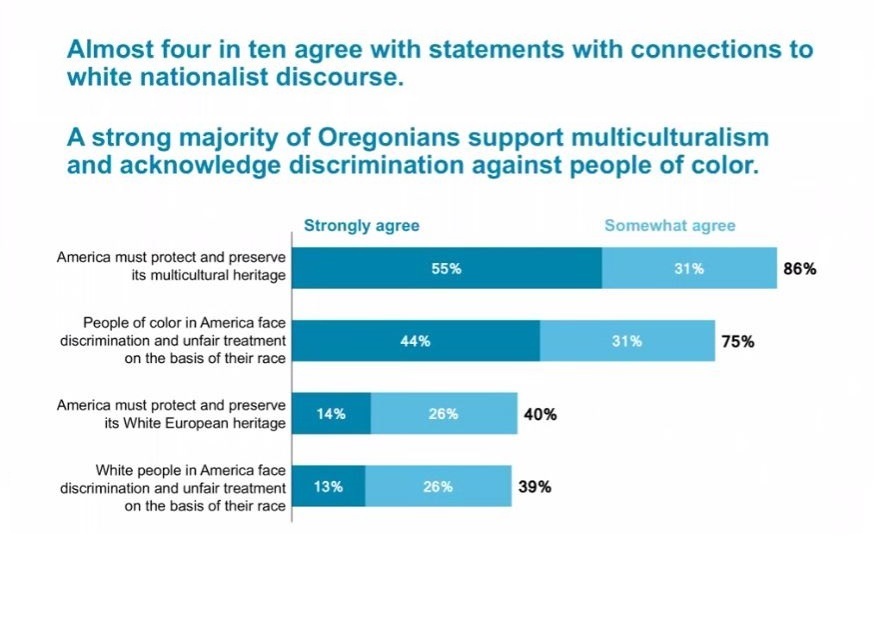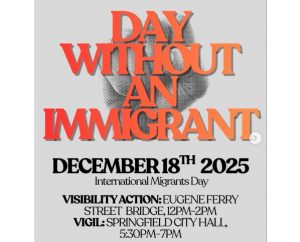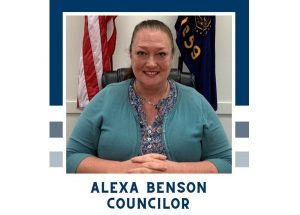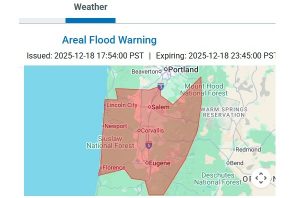Oregon targeted by white supremacists; poll shows majority favor multiracial democracy
5 min read
While recent polls showed troubling trends, a majority of Oregonians support a multiracial, multicultural democracy.
Eric Ward: I’m often asked why white nationalism is such an issue in our region, why we might think this is. Often, we say that our region ended up being disproportionately white compared to the rest of the country. But of course our region didn’t just start out that way, which is why I like to remind myself and others that the Northwest whiteness is a result of exclusion by design.
John Q: [00:00:29] Eric Ward, executive director of the Western States Center, joined others to discuss a recent poll.
Eric Ward: [00:00:36] We’ll discuss what this means for Oregon and for our region. Now, I’d like to turn things over to Lindsay Schubiner, who is our Director of Momentum at Western States.
Lindsay Schubiner: [00:00:48] Thank you so much, Eric. I think a really key piece of data and a disturbing one that almost four in 10 Oregonians, strongly or somewhat agree with statements that align with core arguments of white nationalist and other far-right groups. Statements like: “America must protect and preserve its white European heritage” and that “White people in America face discrimination and unfair treatment on the basis of their race,” these numbers, right? show that they’re certainly not the majority, but I think this data does give insight into the size of the population that white nationalists may be able to appeal to or potentially recruit from.
Thank you for supporting
local citizen journalism
And yet, despite that fairly high number it’s still a dominant majority of Oregonians acknowledge the value of multiculturalism and the reality that racism against black and indigenous communities and other communities of color exists.
Public opinion does appear to be headed in a potentially a troubling direction in terms of increasing openness to core white nationalists’ arguments and slightly weakened in support for multiculturalism over the second half of the Trump administration. Those who agree that American must protect and preserve its multicultural heritage decreasing from 2018 to 2021.
Open support for white nationalism and paramilitarism is much lower than openness to key white nationalist arguments. But this is still far from an insignificant number with 14% of Oregonians, strongly or somewhat supporting paramilitary or militia groups and 11% of Oregonians strongly or somewhat supporting white nationalists. We also see a rise in that open support for white nationalism even just since last summer.
I think in terms of taking the ways from this data I think we can see that there’s urgent work to be done, to close the political space for white nationalist organizing, especially given the number of people open to their messages.And yet, also the number of people supportive of a multiracial democracy is much greater at the same time.
There’s rising dissatisfaction with democracy, especially among young Oregon, just as white nationalists and paramilitary groups work to undermine inclusive democratic governance from the local level to the state and federal levels.
And there’s widespread recognition of the harm of political violence and harassment tactics significantly relied upon by white nationalists and far right and paramilitary groups to civic participation, businesses, democracy, and the economy.
John Q: [00:03:27] Eric Ward said these numbers reflect our history. White nationalist groups picked the Pacific Northwest as their base. They called their plan: the “Northwest Territorial Imperative.”
Eric Ward: [00:03:39] Some who called themselves white supremacists cast themselves as American patriots, they believed the multi-racial equitable democracy would fall apart on its own. They decided that it was time to plan for the collapse and secure a region for themselves. They looked at the demographics of the country, and, as you’ll be unsurprised to hear by this time, they picked the Pacific Northwest.
They called this idea “the Northwest Territorial Imperative” and leaders like Richard Butler and David Lane called for white separatists to move to our region en masse. Local communities and the region became subject to routine intimidation: the murder of Mulugeta Seraw in Portland, the murder of a radio talk show host and journalist, Alan Berg in Denver, Colorado, the attempted bombings of city hall in Spokane, the Spokane, Spokesman- Review’s, newspaper offices, and the Planned Parenthood clinics there as well.
A white separatists group ramped up their antigovernment rhetoric and began to attack institutions as well as people. The federal mishandling of Ruby Ridge became a flashpoint and help lead to the Oklahoma City bombing.
Militia movements went from explicit anti-Semitism and racism to talking about “one world government” and, stripping the most explicit anti-black rhetoric from their talk about government dependency, they used code words and dog whistles like “inner city” and “welfare queen.” Later they’d reserved their clearest animus for immigrants, especially Muslims, pivoting to the argument that they had quibbles with foreign culture, not other races.
Hardcore racists went underground and became early adopters of technology like Usenet groups and Internet message boards. They preferred language shifted from white supremacy to white separatism and were both associated with cultists, Klan robes, and violent skinheads.
It is at this point that there has been a disturbing turn back toward the model of last resort: separatism. Existing successionist movements like the “Greater Idaho” and “Liberty State” are playing with the same idea that our rugged rural culture east of the Cascades is somehow incompatible with West Coast progressives. I’m guessing you can hear the echoes of racism, homophobia, and transphobia in that statement.
Leaders of anti-Semitic, neo-Nazi terrorist group, The Base, purchased a piece of land in Ferry County, Washington. The Base and similar groups already support earlier separatists’ theory of causing chaos through terrorism. And local headlines have shown brazen activity by anti-immigrant anti-democratic hate groups working to build their political power, the willingness of a state elected official, Nearman, to open the doors to those who were seeking violence, to attacks on the Oregon Holocaust Memorial and the distribution of anti-Semitic fliers.
John Q: [00:07:08] Lindsay said while the poll shows support for a multi-racial democracy, we have our work cut out for us.
Lindsay Schubiner: [00:07:15] This data, really, it shows us the scale of the work to be done, to defend our democracy and make it more equitable; the vulnerability of many Americans to white nationalists, messages; as well as, I think, a significant amount of hope, because the majority of Oregonians do believe in racial justice and multi-racial democracy.




